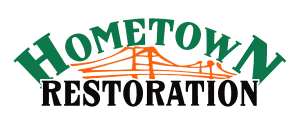When trees damage your home, you need a San Antonio storm repair contractor who understands the challenges
Summer in the South brings high winds that assault trees and heavy rains that saturate the ground, creating the perfect condition for downed trees. One of the most common types of storm damage Hometown Restoration sees are trees falling onto houses. But not every tree-damaged home is the same. In fact, far from it.
Hundreds of factors impact the kind of damage and destruction your home faces when you’ve had a tree fall. Here are just a few examples of tree-damaged homes and what you can expect if you awaken to that dreaded crash in the night.
 Tree branches damage shingles and decking
Tree branches damage shingles and decking
By far the most common kind of tree damage Hometown Restoration sees is caused when a branch falls from a tree and lands on the roof. At the same time, this kind of damage can be one of the worst kinds, because it’s not immediately apparent that the roof has been compromised. Too often, homeowners will simply climb on the roof, remove the offending branch, and go about their lives — only to discover days, weeks, or even months later that their roof was damaged and is now leaking.
“Shingles are tough, but they aren’t indestructible,” cautions Hometown Restoration’s Brad Gardner. “Even a small tree branch, weighing just a few pounds, can punch a hole in a shingle that the untrained eye doesn’t see. That means, at some point, water can get into your attic, damaging your house.”
That’s why Brad recommends having a roof inspection any time you’ve experienced the potential for storm damage. The sooner you act, the smaller the repair may be, because once water gets into the attic and damages the ceiling, the repair bill can triple — or more.
A tree crashes into the attic
 Houses are built tough enough to withstand storms, high winds, even the occasional branch on the roof. However, when a tree lands across your house and crashes into the attic, the damage can seem overwhelming. But it doesn’t have to be.
Houses are built tough enough to withstand storms, high winds, even the occasional branch on the roof. However, when a tree lands across your house and crashes into the attic, the damage can seem overwhelming. But it doesn’t have to be.
“A tree in an attic is frightening, but it’s not the end of the world–or even of your house,” Brad says. “Hometown Restoration will work quickly to remove the tree and assess the damage in the attic so that we have a clear understanding of the scope of the work that will be needed — and we work with your insurance company to make sure your claim covers the damage.”
Insurance adjusters are important parts of disaster response, but they can only see so much. After the tree is removed from the attic, it’s not uncommon to find broken joists, damaged trusses, torn air conditioning ducts, or compromised electrical systems. And, unfortunately, it isn’t until demolition is done and repairs begin that the full scope of damage can be truly assessed. Hometown Restoration is a trusted leader in insurance restoration claims, and we provide you with the knowledge andassistance to work with your insurance company to assess the damage and to put your home back right.
What to do if a tree falls on your home
In the moments after a tree comes down on your home, your first thoughts are for safety of your family and then of your property. Hometown Restoration specializes in rapidly responding to our customers to ensure the damage to your home is minimized and then repaired quickly. If your home has been impacted by a storm, do not wait. Use the form below to contact Hometown Restoration of San Antonio immediately so that we can get to work putting your life back together.
